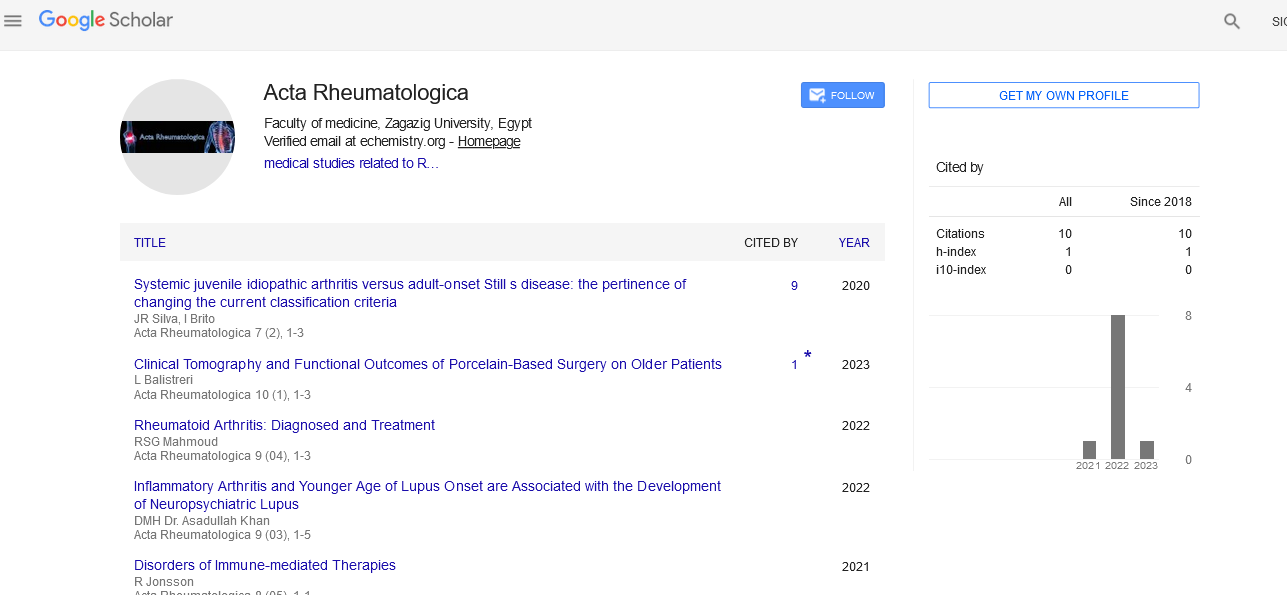Perspective - (2024) Volume 11, Issue 6
Synovial Fluid Analysis in Diagnosing Rheumatic Diseases: Techniques and Interpretation
Michel David*
Department of Medical Sciences, Herbert Wertheim College of Medicine, United States
*Correspondence:
Michel David, Department of Medical Sciences, Herbert Wertheim College of Medicine,
United States,
Email:
Received: 12-Nov-2024, Manuscript No. PAR-24-15242;
Editor assigned: 15-Nov-2024, Pre QC No. PAR-24-15242 (PQ);
Reviewed: 29-Nov-2024, QC No. PAR-24-15242;
Revised: 10-Dec-2024, Manuscript No. PAR-24-15242 (R);
Published:
17-Dec-2024
Introduction
Synovial fluid analysis is a crucial diagnostic tool in
rheumatology, providing valuable insights into various
rheumatic diseases. This diagnostic method helps distinguish
between different types of arthritis and other joint disorders by
analyzing the characteristics of synovial fluid obtained from joint
spaces. Understanding the techniques involved and the
interpretation of results is essential for accurate diagnosis and
effective management of these conditions.
Understanding synovial fluid
Synovial fluid is a viscous liquid found in the cavities of synovial
joints. It serves several key functions, including:
Lubrication: It reduces friction between articular cartilages
during movement.
Nutrient supply: It provides essential nutrients to cartilage
and helps in the removal of metabolic waste.
Shock absorption: It helps distribute loads across the joint,
reducing impact on the bones.
Alterations in the composition and characteristics of synovial
fluid can indicate underlying pathological processes, making its
analysis a valuable component in diagnosing rheumatic diseases.
Description
Techniques for synovial fluid analysis
Aspiration: The first step in synovial fluid analysis is aspiration,
also known as arthrocentesis. This procedure involves the
following:
Preparation: The patient is positioned comfortably, and
the area is cleaned with antiseptic. Local anesthesia may
be administered for comfort.
Needle insertion: A sterile needle is inserted into the
joint space to withdraw synovial fluid. Common joints for
aspiration include the knee, hip, and shoulder.
Fluid collection: The fluid is collected in sterile tubes for
subsequent analysis.
Laboratory analysis
Once collected, synovial fluid undergoes a series of laboratory
tests, typically categorized into three main areas: Physical
examination, chemical analysis, and microbiological examination.
Physical examination
Appearance: Normal synovial fluid is clear and pale yellow.
Cloudiness or turbidity can indicate inflammation or infection.
Viscosity: Normal fluid is highly viscous. Decreased viscosity
may suggest inflammatory processes.
Volume: Excess fluid (effusion) can indicate joint pathology.
Normal volumes vary depending on the joint but may be up to a
few milliliters in healthy joints.
Chemical analysis
Cell count and differential: The total White Blood Cell (WBC)
count is critical. A normal WBC count is typically below 200
cells/μL. Elevated counts suggest inflammation:
• Non-inflammatory conditions: <2000 WBCs/μL, primarily
lymphocytes.
• Inflammatory conditions: 2000–100,000 WBCs/μL, often
with neutrophils predominating.
• Septic arthritis: >100,000 WBCs/μL, with a predominance
of neutrophils.
Crystals: Microscopic examination can reveal the presence of
crystals, such as monosodium urate (gout) or calcium
pyrophosphate (pseudogout), which are key in diagnosing
specific types of arthritis.
Glucose level: Comparison of glucose levels in serum and
synovial fluid can help diagnose infections. Lower synovial fluid
glucose levels may indicate septic arthritis or rheumatoid
arthritis.
Microbiological examination
Culture: Bacterial cultures of synovial fluid can identify
infections, especially in cases of suspected septic arthritis. This is
crucial because early treatment of infections can significantly
improve outcomes.
Gram staining: A rapid method to detect bacteria, though it
may not always yield positive results.
Advanced techniques
In addition to routine analyses, advanced techniques may be
employed for further diagnostic precision:
PCR testing: Polymerase Chain Reaction (PCR) can detect
bacterial DNA, aiding in the diagnosis of infections that are not
easily cultured.
Cytological examination: Evaluating the cellular composition
of synovial fluid can help identify malignancies or atypical cells in
conditions like synovial sarcoma.
Biomarker analysis: Investigational techniques involve
measuring specific biomarkers in synovial fluid, which may
provide insights into the inflammatory processes involved in
rheumatic diseases.
Interpreting synovial fluid analysis results
Interpreting synovial fluid analysis requires a thorough
understanding of the underlying pathophysiology of rheumatic
diseases. Here’s how to interpret key findings:
Inflammatory vs. Non-inflammatory
Inflammatory conditions: Elevated WBC counts with neutrophil
predominance often suggest inflammatory arthritis such as
rheumatoid arthritis, psoriatic arthritis, or septic arthritis. A cloudy
appearance and low viscosity further support this.
Non-inflammatory conditions: Normal WBC counts and clear
fluid are consistent with osteoarthritis or other noninflammatory
joint conditions.
Infection
In cases of suspected septic arthritis, high WBC counts,
particularly with neutrophil predominance, along with positive cultures, confirm the diagnosis. Low glucose levels in the fluid
can also indicate an infectious process.
Crystalline arthritis
The identification of crystals in synovial fluid is diagnostic.
Needle-shaped monosodium urate crystals confirm gout, while
rhomboid-shaped calcium pyrophosphate crystals indicate
pseudogout.
Autoimmune disorders
In conditions like rheumatoid arthritis, synovial fluid may
exhibit elevated inflammatory markers, but definitive diagnosis
often requires correlation with clinical findings and serological
tests.
Clinical implications
The analysis of synovial fluid is instrumental in diagnosing and
managing rheumatic diseases. Accurate interpretation can guide
treatment decisions, such as the initiation of Disease-Modifying
Antirheumatic Drugs (DMARDs) or the need for surgical
intervention in cases of joint infection.
Conclusion
Synovial fluid analysis is a vital tool in the diagnosis of
rheumatic diseases, offering insights that can significantly
influence patient management. Through careful aspiration,
laboratory analysis, and interpretation of results, healthcare
professionals can effectively differentiate between various
arthritides, ensuring timely and appropriate treatment. As
techniques evolve and new biomarkers are identified, the role of
synovial fluid analysis in rheumatology will continue to expand,
further enhancing our ability to manage these complex
conditions. Emphasizing the importance of this diagnostic
method can ultimately lead to improved patient outcomes and a
better quality of life for those affected by rheumatic diseases.
Citation: David M (2024) Synovial Fluid Analysis in Diagnosing Rheumatic Diseases: Techniques and Interpretation. Acta Rheuma Vol:11 No:6





